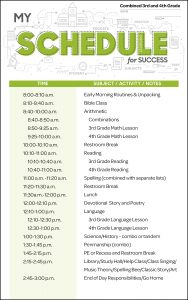Serving a small community, adding grades to your school, or weathering a downturn in enrollment are all reasons that combining classes might make sense for your school. You might find that combining two grades per teacher is the most logical solution based on enrollment and staff. An energetic and willing teacher can teach combined classes well. To successfully combine two grades in the third through sixth grades, you will teach most subjects together, use seatwork strategically and make adjustments to the schedule.
Third and fourth grades combine well, as do fifth and sixth. Most subjects will be combined and taught from either grade’s materials; you may choose which grade based on your class situation. For example, if you are adding sixth grade for the first time, then you probably just taught fifth grade materials. This year, it would be logical to teach most subjects using the sixth-grade materials. Next year you would teach from fifth grade again. However, if you plan to separate grades next year based on your growth plan, you will need to adjust the schedule to teach both grades simultaneously from their own materials.
When you teach from the higher grade, you should prepare for concepts that are a big step up for the younger students. For instance, note how a concept was introduced in third grade so that when you teach from the fourth-grade curriculum, you can use the introductory method instead of the review method. Your secret weapon to anticipate challenges is your detailed scope and sequence—the introduction of a concept is in red letters. Keep an eye on the third-grade red letters when you teach from the fourth-grade materials or the fifth-grade red letters when you teach from sixth.
Seatwork
To make your plan work, you need to occupy one grade while you instruct the other. That is where seatwork comes in like a superhero! At the beginning of the year, train your class to work independently on seatwork. They need to know to save questions for the time between groups and to move on if they get stuck. To augment seatwork, students may also work on homework from a subject that they have already taught that day. This replaces the study hall since you will not have time for it in the schedule.
Language
In third and fourth grade, teaching language separately in your schedule would be ideal. However, it is possible to combine them, teaching from one book and alternating the next year. If you combine, be aware of the new material as mentioned above. From fifth to sixth grade, there is not much new material. Still, watch for those concepts that are challenging and use the same technique to help your class. Also, be aware of the rotation of the grades coming into your class: If you are receiving fourth-graders who just used third-grade materials, they may need to be refreshed on certain concepts.
Reading
Because third grade begins with a phonics review in reading, it is best to have students read from their own books. While they read, have fourth grade do seatwork; then read with fourth grade while third grade does seatwork. A weak fourth-grade reader may join third grade to take advantage of that phonics refresher; he will also read with his grade. Grade him only on the reading he does on his grade level since the other is only to strengthen his skills. Fifth and sixth grades may read together; they will benefit most from time to discuss literary concepts.
Spelling
Since third and fourth grades are not reading together, they should also study their own spelling books because the lists correlate with their readers. Fifth and sixth graders will work from the book that correlates with their readers.
Writing
By third grade, students have learned all cursive letter formations and are concentrating on writing smaller, writing single-spaced, and mastering difficult letter connections. You may easily combine the class. Display cursive letter formation cards for your students to refer to as they practice.
Arithmetic
The two grades take speed drills and tests at the same time, but they will be instructed separately because each grade emphasizes a specific concept. Third grade concentrates on multiplication and division tables; fourth on fractions; fifth on decimals; and sixth on percents. Keeping the instruction separate will allow those skills to build.
Whenever possible, do combinations together, although you might give each group combinations from their level early in the year. Do not be surprised to see the younger students catching on to the more advanced material and being able to compete before the year is over!
History/Health/Science
Plan to combine your grades for these subjects because the class will benefit from time for discussion and demonstration. Be aware that third graders may read more slowly and accommodate for that with shorter reading segments for them. When you teach out of the fourth-grade history book, you will need to cover two lessons per day to complete the curriculum. Fifth and sixth need to do two lessons a day for both history and science/health.
Activities: Library, PE, Art, Music, Study Hall
Activities are scheduled in the afternoon after the core subjects, and they get very little time. Prioritize how to use that time. Most likely, you will not have time for study hall, but your students have had extra seatwork time during arithmetic that will help them. On days with PE, you would not need afternoon recess; on days with chapel, you might not have Bible class, freeing up time to use for activities. All of your activities should be combined to maximize the time.
Creativity and flexibility make a combination classroom a success. You will be tired, but your students will be on track!





Comments for Combinations to Maximize Opportunity: 3rd-6th Grade Combination Class Suggestions
Add A Comment
Your email address will not be published. Required fields are marked *